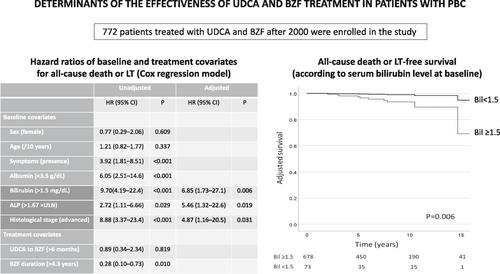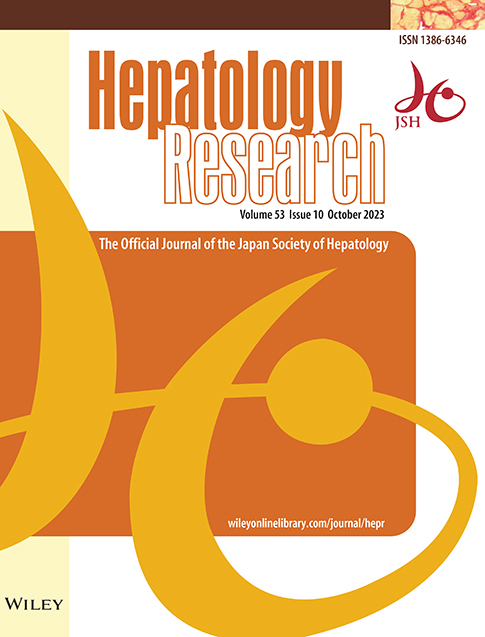Determinants of the effectiveness of bezafibrate combined with ursodeoxycholic acid in patients with primary biliary cholangitis
Abstract
Background and Aims
For patients with primary biliary cholangitis (PBC) exhibiting suboptimal responses to ursodeoxycholic acid (UDCA), obeticholic acid (OCA), and bezafibrate (BZF) are currently used and shown to improve long-term outcomes. Nevertheless, we encounter patients who die or undergo liver transplantation (LT) even with combination treatment. In this study, we explored prognostic indicators in patients receiving combination treatment of UDCA and BZF.
Methods
We took advantage of the Japanese PBC registry and enrolled patients who received both UDCA and BZF therapy in 2000 or later. The covariates investigated included baseline covariates as well as treatment covariates. Two main outcomes (all-cause death or LT and liver-related death or LT) were assessed using multivariable-adjusted Cox proportional hazards models.
Results
In total, 772 patients were included. The median follow-up was 7.1 years. Using the Cox regression model, bilirubin (hazard ratio [HR] 6.85, 95% confidence interval [CI] 1.73–27.1, p = 0.006), alkaline phosphatase (HR 5.46, 95% CI 1.32–22.6, p = 0.019), and histological stage (HR 4.87, 95% CI 1.16–20.5, p = 0.031) were found associated with LT-free survival. For survival free from liver disease-related death or LT, albumin (HR 7.72, 95% CI 1.48–40.4, p = 0.016) and bilirubin (HR 14.5, 95% CI 2.37–88.5, p = 0.004) were found significantly associated.
Conclusion
In patients with PBC receiving combination therapy, prognostic variables were similar to those in patients receiving UDCA monotherapy. These results indicate the importance of diagnosing patients with PBC at an earlier stage because of the reduced effectiveness of BZF at advanced stages.
Graphical Abstract
This study focused on patients with primary biliary cholangitis (PBC) who did not respond well to the usual treatment with ursodeoxycholic acid (UDCA), and received a combination therapy with UDCA and bezafibrate (BZF). The study explored factors that could predict the outcomes of patients who received a combination therapy of two drugs. The results showed that certain indicators, such as high bilirubin levels and advanced histological stage, were associated with the patients' survival without requiring liver transplantation. The study emphasizes the need for early diagnosis of PBC to improve the effectiveness of the combination treatment.
CONFLICT OF INTEREST STATEMENT
Dr. A. Tanaka reports receiving consultant fees from EA Pharma, GlaxoSmithKline, Kowa Company Ltd., and Gilead Sciences. No other potential conflict of interest relevant to this article was reported.
Open Research
DATA AVAILABILITY STATEMENT
The dataset generated during this study is available from the corresponding author upon reasonable request.





